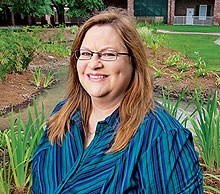sierraclub.org - sierra magazine - September/October 2009 - act: slow the flow


Act | On Your Convictions
Slow the Flow
Interview by Mary Ann Sternberg
 Dana Brown, Baton Rouge, Louisiana; landscape architect
Dana Brown, Baton Rouge, Louisiana; landscape architect"My least favorite word is 'wastewater.' We should think of ways to reuse water, not get rid of it.
"Here in south Louisiana, we average 60 inches of rainfall annually. We get localized flooding and significant standing water even after normal rainstorms, and then polluted water gets released downstream. The quality of most of our water bodies is classified as 'impaired,' meaning they are not fishable or swimmable.
"I'm a native of New Orleans and moved back to Baton Rouge from California in 2002. My business partner and I run a practice to help influence regional planning, especially in the area of stormwater management.
"What I advocate is essentially biomimicry--imitating natural systems to create sustainability. Nature did R&D over 3.85 billion years to figure out what works and lasts.
"My approach is to extend the length of time it takes water to move through and away from a site by routing it through bio-swales [long, gently sloped depressions], rain gardens, and wetlands. Much less water drains downstream, and the plants filter out nitrates, sediments, and bacteria. It's efficient, sustainable, and cost-effective.
"We did a project for a local school [Episcopal High School of Baton Rouge] where the gym flooded whenever it rained, and where the quad outside was always muddy. We reconfigured the land to pitch toward new bio-swales and ponds underlaid with gravel and sand to make them permeable. We also dug columns and filled them with gravel to move water underground. We planted native wetland plants and transformed it into a rain garden. The first time there was a deluge, the coach bounded out of the gym, yelling, 'My floor is dry!' Now the students use the quad all the time.
"People don't realize where rainwater goes, so it's critical to help them understand this process and why it works."
Miracle Grow Bio-swales and rain gardens planted with native vegetation receive stormwater from impervious surfaces and filter 95 percent of oil and grease, 99 percent of heavy metals, 40 percent of nitrogen, and 80 percent of coliform from the polluted runoff.
On the Web Read more about Brown's work at browndanos.com and about the Episcopal High School's rain garden at tinyurl.com/nfws6q.
Photo courtesy Tim Mueller; used with permission